#Oedipus Complex
Explore tagged Tumblr posts
Text
Sigmund Freud

♈ Bharani Sun (atmakaraka), Ashwini Venus (lagnesha) and Rahu in the 7H
♉ Rohini moon and Krittika Mercury in the 8H
♎ Swati ASC and Chitra Ketu in the 1H
♍ Hasta Mars (Rx) in the 12H in opposition with Uttara Bhadrapada ♓ Jupiter in the 6H
♊ Mrigashira Saturn in the 9H
#astrology observations#vedic astrology#atmakaraka#lagnesha#sigmund freud#freud#oedipus complex#rohini moon#swati nakshatra#moon in the 8th house#mercury in the 8th house#aries sun#bharani sun#sun in the 7th house#venus in the 7th house#rahu in the 7th house#ketu in the 1th house#chitra nakshatra#swati asc#mars in the 12th house#jupiter in the 6th house#saturn in the 9th house#krittika nakshatra#hasta nakshatra#uttara bhadrapada#ashwini nakshatra#sun atmakaraka#nakshatras#vedic notes
67 notes
·
View notes
Text

The Death of the King (detail), Agnieszka Polska, 2009
51 notes
·
View notes
Text
The Taboo Thrill
Most people do not realize "the taboo thrill" is a significant and ever present part of having a romantic/sexual relationship with your mother. The very first time the taboo thrill crops up is when you find you have sexual feelings for Mom. Although you try to deny them, they get stronger and stronger. The next taboo thrill is when you have to accept that you are truly, helplessly in love with your mother, and you are "ruined" for any other female ever. The next taboo thrill comes from realizing you are tempted to pursue and flirt with your mother. A very big taboo thrill comes when you actually give in to love/lust and you start heavily flirting with and pursuing your mother. A huge taboo thrill came for me when I began dating Mom, and then when rumors/gossip began, trying to keep it all hidden was a taboo thrill. The ultimate taboo thrill of course is when you first "get back inside" your mother. I know for me it was my dream had come true, here I am banging my mom. It was the best of all. From then on that taboo thrill remains, but is joined by another taboo thrill, that of each time I "slide back into my sexy mother" the very real risk I get her pregnant. That is a constant taboo thrill. Especially when you do not want it to happen, yet you do. It arouses you to think of it happening, and everyone knowing (or suspecting) you are the one who got your mother pregnant. Then for me a taboo thrill came (besides the nervous/scared part) whenever people started and kept finding out it is true that Mom is my girlfriend, and again as word spread. (Believe me, the first time we got caught in the act was a huge taboo thrill. Then each time we got caught "doing it", or caught in boyfriend/girlfriend activities, it was a tremendous taboo thrill. The next taboo thrill was knowing everyone would now know, whether I was prepared for that or not. Denying the whole thing was now a long gone thing I could do. And the most recent taboo thrill is when on a dare from people who know me (and know what Mom and I get up to), I made my blog to be about my being in love with Mom, about my mother being my girlfriend. I changed my username to OedipusTed, to point out my Oedipus Complex. As I got into blogging about it, it is a taboo thrill writing about it all. I figured no one would be interested and after several months I would just remove my blog. A significant taboo thrill occurred when I discovered there is some interest in this affair (people who dared me said there would be; they were right), and lots more people would be finding out my "secret". So yes, I have to say for me, my mother being my girlfriend and my lover has provided many instances of "the taboo thrill" so far.
#oedipus complex#secret revealed#rumor confirmed#truth revealed#famous in small town#secret affair#exposed secret#secret no longer#tabooromance#public secret#in love with mom
44 notes
·
View notes
Text

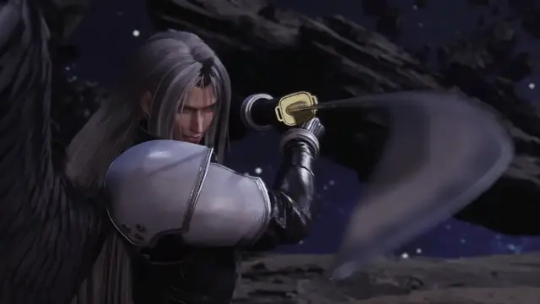
#oz cobb#oswald cobblepot#oswald cobbelpot#sephiroth#the batman#batman#dc#final fantasy vii#final fantasy#ff7#polls#tumblr polls#oedipus complex
28 notes
·
View notes
Text
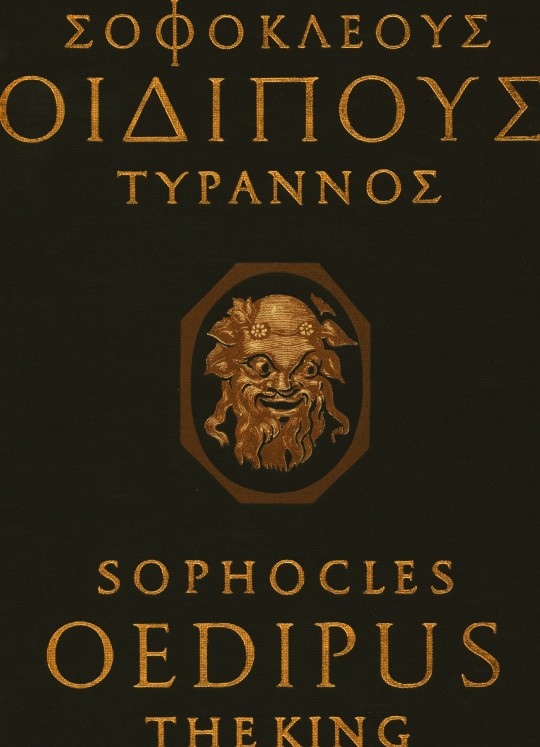
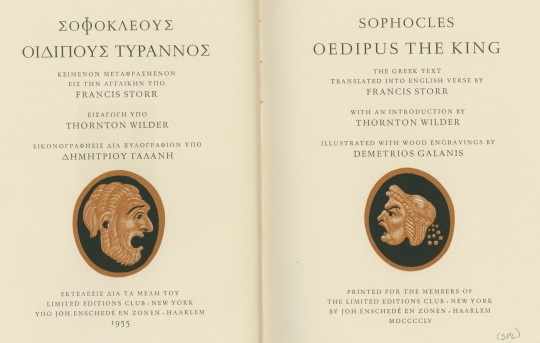
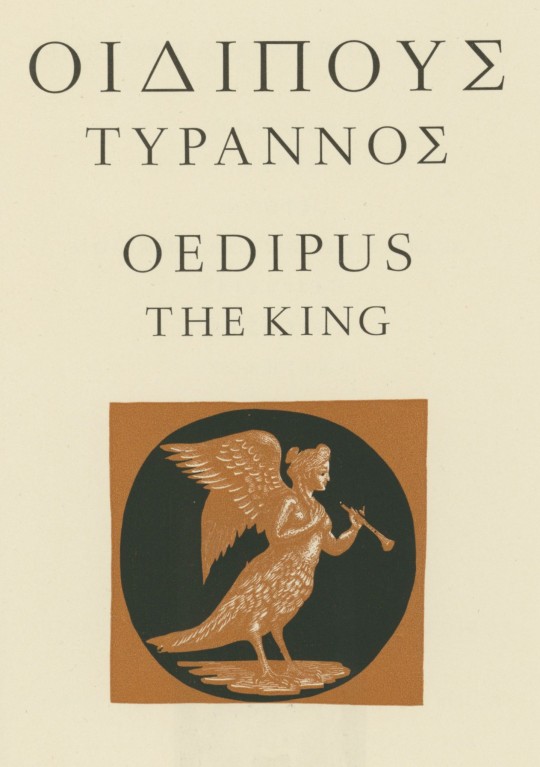


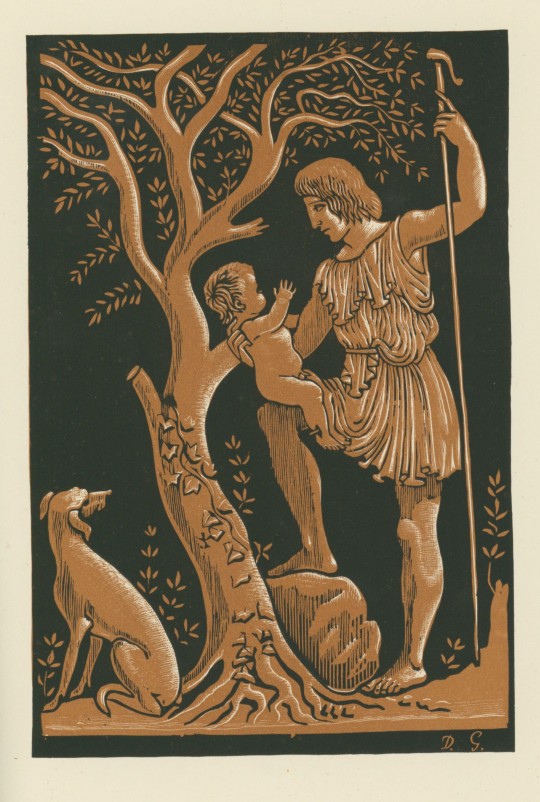
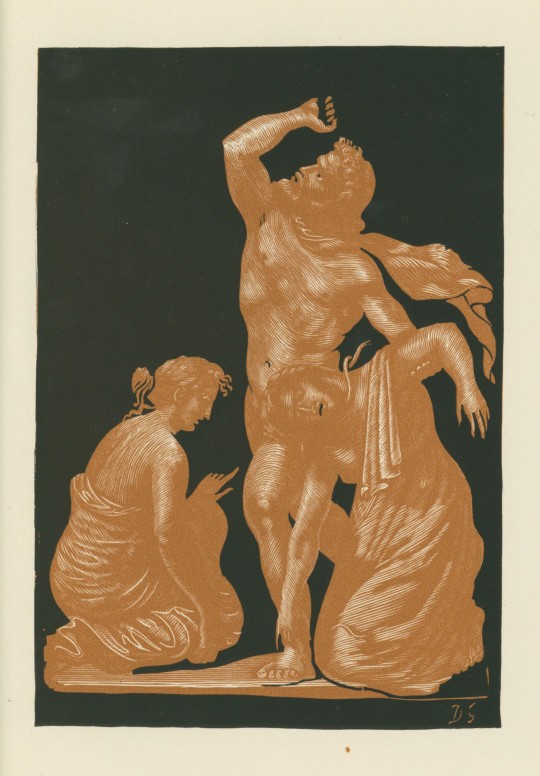

Tragically Greek
This 1955 edition of Oedipus the King, written by Sophocles, features the original Greek text alongside the English verse translation. Offering a rich, immersive reading experience results from hard work, dedication, and creative minds coming together to create this masterpiece.
Jan van Krimpen (1892-1958), Dutch typographer, book designer, and type designer, designed the two typefaces. The Greek type is named “Antigone,” and the English type is called “Romulus.” The translator for this work was Francis Storr (1839-1919), a British classicist, translator, and teacher.
The paper was specially manufactured at the historic Dutch Pannekoek Papermill, a mill with a rich history that unfortunately met its end in a fire in 1944. This exclusive feature adds a touch of rarity to your reading experience. Printed in the offices of Johannes Enschedé, under the supervision of Mijnheer van Krimpen, it was for the members of the Limited Editions Club.
Adding to the richness of this edition is the detailed and insightful introduction provided by Pulitzer Prize winner Thornton Wilder (1897-1975), American playwright, novelist, and native of Madison, WI. His esteemed perspective offers an enlightening preface to the classic tale.
The illustrations are black and terra-cotta wood engravings designed by Greek artist Demetrios Galanis (1879-1966). He was the trailblazer of modern Greek engraving and was once touted as one of the greatest living Greek artists at the time of the book’s release.
Sophocles (c. 497/496 – winter 406/405 BC) was an ancient Greek playwright born in Colonus near Athens. He is one of the three great tragedians of classical Athens, along with Aeschylus and Euripides. Sophocles wrote over 120 plays during his lifetime, although only seven have survived in their entirety. His works are characterized by their complex characters, well-crafted plots, and profound exploration of moral and philosophical themes.
Among his most famous plays is the tragedy Oedipus the King. The story is about Oedipus, the king of Thebes, who tries to uncover the truth behind a plague that has struck his city. In doing so, he discovers that he himself is responsible for the plague, having unknowingly killed his father and married his mother. The play delves into themes of fate, free will, and the consequences of one's actions.
-Melissa, Special Collections Classics Intern
View other Classics posts
#classics#sophocles#oedipus#oedipus rex#oedipus the king#greek mythology#greek#wood engraving#athens#tragedy#greek tragedy#ancient greece#oedipus complex#Limited Editions Club#Johannes Enschedé#Enschedé#Jan van Krimpen#Antigone type#Romulus type#Francis Storr#Demetrios Galanis#Pannekoek paper#LEC#Thornton Wilder#Melissa
66 notes
·
View notes
Text
Sigmund Freud is the OGMF
(original mother fucker)
61 notes
·
View notes
Text
Sometimes I wonder what if Freud was right all along. My friend pointed out that Kim Wexler and Saul Goodman that I simp over on regular basis literally look like my parents. And they do. I can't get over it

#kim wexler#saul goodman#jimmy mcgill#fangirl#hyperfixation#sigmund freud#electra complex#oedipus complex#im going to kms#how do you even live with that
4 notes
·
View notes
Text
anyone else get the feeling it's possible vogelbaum lied to homelander about what happened to becca *with* the truth of what happened to his own mother/surrogate (exception to artificial womb of course but this *is* vought which i feel makes the most ethically responsible choice for bringing a super fetus to term somehow the least viable for them)?
also, been wondering a little while what the hell stormfront hated vogelbaum so much for (doubtful it was what happened to homelander given how much she LOVED how he turned out...) and it had me wondering leik...
did he steal an egg from her or something? is that the set up here??
and then of course, the spiral.
gais, think homelander might *actually* be oedipus here, or at least set up to become oedipus (just the killing his father thing left over)... but color me shocked if they don't go full oedipus with homelander.
#homelander#the boys#the boys meta#jonah vogelbaum#just thinkin' i guess#john gillman#homelander meta#meta#stormfront#oedipus#oedipus complex#y'all
25 notes
·
View notes
Text
"One plus one...that makes two. One plus one makes two. You can not make one. Jeanne? One plus one, does it make one?"
#quotes#incendies 2010#incendies#shocking revelation#plot twist#mathematical question#dysfunctional family#oedipus complex#mommy issues#absent father#long lost siblings#1 + 1 = 1#one plus one equals one#psychological horror#nawal marwan#abou tarek#simon marwan#jeanne marwan#tw inc*st#tw abuse#long lost brother#long lost father
37 notes
·
View notes
Text
Recovering the maternal in art
Thoughts on Hamlet #1
A crazed rant on Hamlet, art in modernity, Susan Sontag, and female power in Christian theology

The feminine urge to be daddy's mommy. — — Natalie Wynn, Contrapoints
This is the first of my series of meditations based on Shakespeare’s Hamlet, which I have been studying as part of English literature A-level. It is the basis on which I expand into wider general reflections on culture and philosophy, linking to other things I’ve read or watched recently.
This piece begins as art criticism about excessive author presence in modern art, with allusion to Hamlet as an embodiment of such modern artist. But then it kind of diverges into a theological tangent and ultimately an argument about gender and female power in Christian myths.
It doesn’t really neatly belong to any specific literary category. It is essay-like, but is full of poetic logic. Perhaps just read it as a kind of unhinged diary entry or notes app notes that should have stayed in the drafts.
— — Z
1
Modern authors, perhaps due to their peculiar awareness of themselves as authors, have felt this exceeding sense of self-inflicted obligation, that they have to force their authorships onto the audience, to make them aware that what they’re seeing, is in fact, created by them. And not just by the world.

‘What a piece of work / Is a man!’ Hamlet, II, ii, 301–302
What I mean by this could be seen most obviously in the attempt that modern authors try to push “message” into their works, or simply the conscious attempt to have any message at all. Consciousness is really the crime here. There is a kind of forcedness in modern art, a lack of the grace, the relaxed effortlessness that is so prevalent in classical, canonical art. Modern art is always agitating, in a permanent state of anxiety and uncertainty in whether it has “correctly” communicated its message to its audience.
Notes: Hamlet is seen by many as Shakespeare’s most philosophical play, his most message-heavy work, with deep contemplations on the nature of existence.
The long soliloquies of the eponymous prince has long been described as rigorously academic in style, perhaps most famously, in the ‘to be or not to be’ soliloquy. It is the most decontextualised soliloquy uttered by the prince, in which he solely speaks on the conceptual matters of life and death.
Yet this intellectual aspect of the play might perhaps what Shakespeare precisely is trying to satirise here. A tormenting, self-cannibalising, painful intellectual interiority, emerging in the early modern West, with its deep Christian moralism and inhuman rationalism, is here presented as precisely what drives the main character, and those around him, into misfortunes.
‘O, what a rogue and peasant slave am I!’
Hamlet, II. ii. 538
The dramatic forcedness of Hamlet's messaging is perhaps most evident in the almost ravage-like scene in Gertrude's chamber (III, vi), in which he almost embodies the incestuous and murderous Nero. 'Let not ever The soul of Nero enter this firm bosom. Let me be cruel, not unnatural.' III. ii. 366-368
Susan Sontag said that art should be flirtation, not rape. Well, many modern art feels like rape to me. They feel like rape in the way that they try to force one singular thing onto its recipient. It refuses a defused, tender sensuality that slowly transmits and triggers desires through a landscape of polyamorous tenderness. Instead, it is strictly patriarchal, scriptural, the word of the Father, of God, Author The Creator. There is a violence to it. But more so there is a naivety to it.
The violence is in the naivety. In its brutal attempt to not appear naive, but rather adultly, scholarly, fatherly, like the son who resolves the Oedipus complex by identifying with the father to escape the fate of castration. The dwarf dressed in the giant’s robes.
‘But two months dead — nay, not so much, not two-
So excellent a king, that was to this
Hyperion to a satyr, so loving to my mother
That he might not beteem the winds of heaven
Visit her face too roughly. Heaven and earth!’
‘My father’s brother, but no more like my father/ Than I to Hercules’
Hamlet comparing his father to his uncle, the current King Cladius, and himself, I. ii. 138–142; 153–154
This is the modern author. The anxious son, boy, fearing castration, if not already castrated, living in the shadow of the father, haunted by him, resenting his mother, the wanton, the whore, the true artistry of the world.
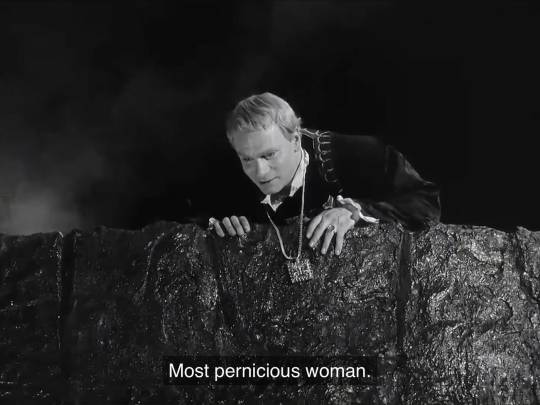
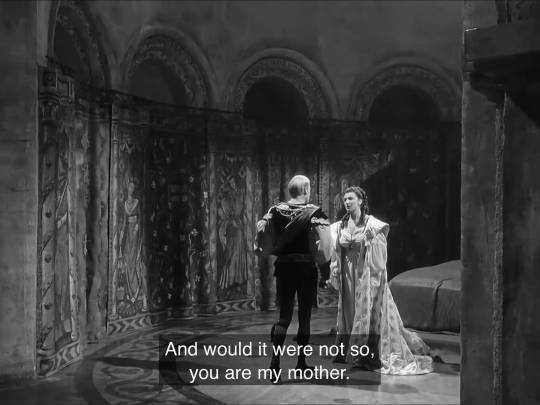
Hamlet (1949). Laurence Olivier
True art is always promiscuous. She is the Saint of All Sins. The Virgin in the Brothel. The Whore in the Church. The Holy Witch. The High Priestess of Filth. She is a woman. She is mother. The Oracle (whose words are obscure because they’re divine, not to Him the God, but the real, hedonistic god of music and joy, through whom she is enlightened in darkness). The Sea. Shall I moor tonight in thee.

Twilight, Contrapoints, Natalie Wynn
He, the God, and Her, Nature, whose fundamental battle is once again reenacted in this.
Genesis 1:2, the Spirit of God moved upon the face of waters. God moved on top of the sea, God on nature, man on woman, reason on art, this is the fundamental violation, the real original sin, the forbidden fruit of knowledge, brought forth by Himself through his very presence. The fault of the Fall is not in us. It is in Him. For to be holy is to be aware of the profane, as the opposite is equally true. Therefore to be profane, to be sinful, is precisely to be aware of the existence of the hallow. To learn about it. To aspire to it. Without sin, there would be no God. Like there would be no man without woman.
‘Whatever is the subject of a prohibition is basically sacred’.
‘The taboo does not banish the transgression but, on the contrary, depends upon it, just as the transgression depends on the existence of the taboo: “The transgression does not deny the taboo but transcends it and completes it”.’
Georges Bataille, Eroticism: Death and Sensuality
‘That discourse one might call the poetry of transgression is also knowledge. He who transgresses not only breaks a rule. He goes somewhere that the others are not; and he knows something the others don’t know.’
Georges Bataille, Story of the Eye
Notes: St. Augustine of Hippo wrote that original sin is transmitted by concupiscence and enfeebles freedom of the will without destroying it. But isn’t will also what precisely drove one (Eve) to the origional sin? Perhaps the will is much like Kant’s conception of freedom, a thing that creates its own limits.
Without an elusive ideal to aspire to, we will never be aware of our skin-felt wretchedness. The fruit is not only planted by God, it is God, it is God who eats the fruit, it is God who is the fruit being eaten, and it is God who is watching all of this.
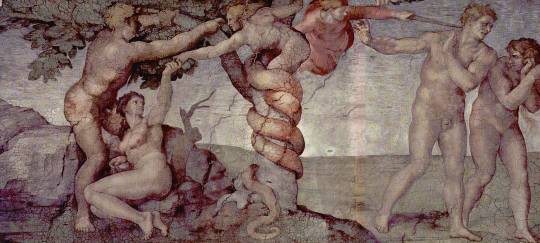
I find it interesting. The closeness between the angel and Satan. Almost mirror images. In Michelangelo’s painting of the sin of Adam and Eve from the Sistine Chapel ceiling.
The decision to have the woman be the one to eat the fruit therefore, is interesting, on multiple levels. She is the original sinner, but also the one closest to God. For the fruit is God, but the fruit is also sin, and it is through the death of the man that she (gives birth to) achieves salvation. She is sin, but she is sin in grace, the glorified sin, the sin made divine, the virgin who gives birth, saved from stoning (here she also mirrors the other Mary, the other permitted sinner, Mary Magdalen), who gives birth to the man who is going to die, through which she successfully redeems herself. She is the mother, and she is the sinner, the original in both, and in both she is holy.
Eve is Mary and Mary is Eve.
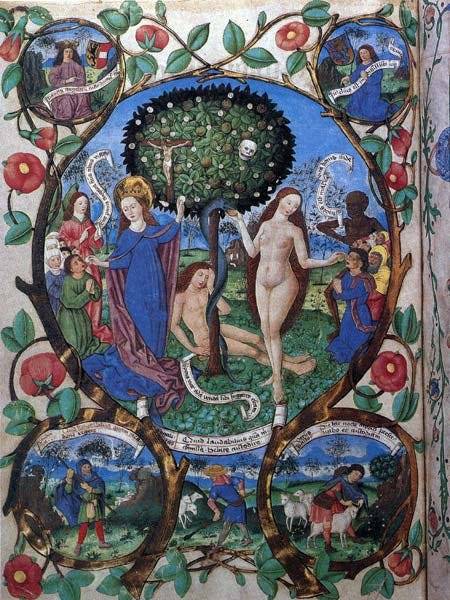
The tree of death and of life in the Salzburg Missal: Eve gives the representatives of the old covenant the fruit that brings sin and death from the tree of paradise. Mary, on the other hand, gives the faith hosts, the bread of life. — — The New Eve (Latin: Nova Eva) is a devotional title for Mary, the mother of Jesus. Since the second century, numerous Eastern and Western Church fathers have expressed this doctrinal idea as an analogy to the biblical concept of the New Adam.
The man is essentially an accessory to her, a passage through which she penetrates through to achieve her eventual goal. He is only a thing that she decorates herself with. The baby in her bosom. The man on her laps (Pietà). The feminine urge to be daddy’s mommy. The gravedigger, whose death goes unmentioned, outlived everyone. Her blue robe is serene, like the halcyon sea.

Sandro Botticelli’s Madonna and Child, painted in 1480, shows a reflective Mary in deep blue.
Z
17.03.2024
(with notes later added 24.03.24)
Source:
Susan Sontag, Against Interpretation, On Style, The artist as examplary sufferer
Natalie Wynn, Contrapoints, Twilight
Georges Bataille, Eroticism: Death and Sensuality, Story of the Eye
Janet Adelman, Man and Wife Is One Flesh: Hamlet and the Confrontation with the Maternal Body
I have also posted this on Medium.
#shakespeare#hamlet#oedipus complex#literature#feminism#catholic core#philosophy#contrapoints#natalie wynn#twilight#georges bataille#eroticism#susan sontag#art criticism#art#literary analysis#literary criticism#diary#rambles#the virgin mary#symbolism#renaissance#ideas#theology#women in art#thoughts#oedipal complex#freudian#mommy issues
33 notes
·
View notes
Text
Freud would read my Tumblr posts and immediately attempt to diagnose me with wants to fuck my mother syndrome but what's this? I am shooting him in the chest over and over again because he doesn't deserve the effort of me laying my hands on him.
37 notes
·
View notes
Text

A photo of my mother's extremely gorgeous and sexy legs. Everytime I see these, whether in nylons, pantyhose, tights, fishnets, or bare, I get driven completely wild with desire. My mother could easily put me into a trance or under a spell, just by showing me her ultra sexy legs. In this photo Mom is wearing fishnets. I have two petnames/nicknames I call Mom. One is Sexy, or Super Sexy. The other is Fabulous in Fishnets. This photo is from when my mother was in a play about the old west.
#oedipus complex#rumor confirmed#secret revealed#truth revealed#secret affair#secret no longer#famous in small town#in love with mom#public secret#fishnet pantyhose#fishnet nylons#mom's gorgeous legs drive me wild#gorgeous legs
35 notes
·
View notes
Text
“If a woman likes an older man is because she wanted to marry her dad when young and still has not gotten over that childish infatuation for her older” gross, why would someone say that.
#Fancying older men ≠ wanting to screw your dad when you were a child#Freud they can never make me love you#Electra complex#oedipus complex
8 notes
·
View notes
Text
The oedipus complex is actually pretty real. Don’t get me wrong, I don’t want to have sexual Intercourse with my mother but think about it… men always want a woman who will take care of them like their mother.
Yet another reason Sigmund Freud is my favourite man in history.
15 notes
·
View notes
Text
'I don't think much good can come from sons fighting fathers, do you?'
Lev Grossman, from The Bright Sword
#succession#logan roy#kendall roy#roman roy#reminds me of#family feud#oedipus#oedipus complex#oedipus rex#tragedy#fighting#quotes#lit#words#excerpts#quote#literature#lev grossman#the bright sword
9 notes
·
View notes
Text
Okay, uhm... what the-

3 notes
·
View notes